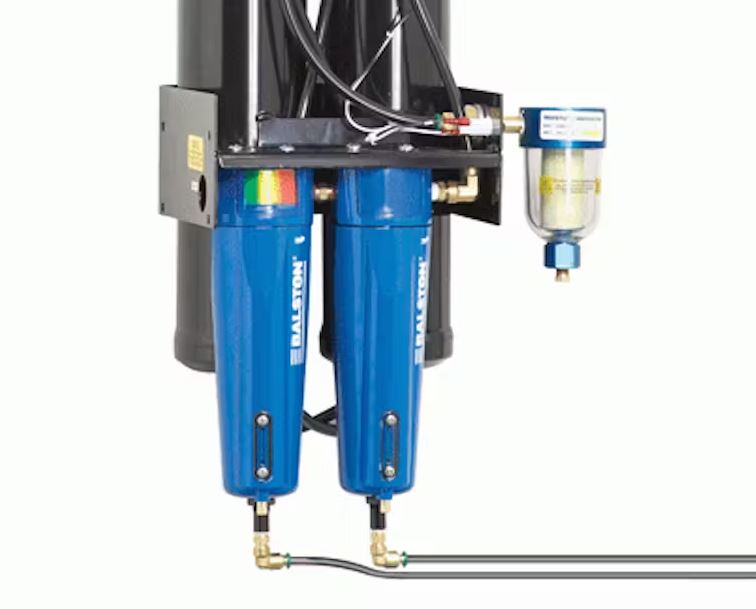Dry compressed air refers to air that has been pressurized and had most, if not all, of its moisture content removed. It’s a crucial component in several industrial applications, specifically those that demand minimal moisture to ensure smooth operations.
In the realm of pneumatic systems, dry compressed air is a must-have. These systems heavily rely on the power of compressed air to operate various tools and equipment. Water vapor in the system can lead to corrosion, frozen controls, and wear and tear on the equipment parts.
The Importance of Dry Compressed Air in Pneumatic Systems
Dry air serves multiple fundamental functions in pneumatic systems. Its primary role is to generate and transmit the energy required for mechanical work. Given its high pressure, dry compressed air exerts a significant force on pneumatic tools and equipment, enabling them to perform their tasks.
But why is it crucial for the air to be dry?
The answer lies in the adverse effects of moisture. Air naturally contains water vapor, which, when compressed, condenses into liquid water. This moisture poses a serious threat to pneumatic systems. It can corrode metal parts, disrupt the smooth operation of pneumatic tools, and even freeze in cold temperatures, causing system failure. By removing moisture, dry compressed air prevents these issues, ensuring optimal performance and longevity of the system. The essentiality of dry compressed air in pneumatic systems cannot be overstated.
How Dry Compressed Air is Produced

The process of generating dry compressed air involves two core stages: compression and drying.
Compression
Initially, ambient air is drawn into a compressor, which pressurizes the air. The act of compression raises the air’s temperature and concentrates its indigenous moisture content.
Drying
Following compression, the high-temperature, high-moisture air is then directed into an air dryer. Here, the moisture is extracted to produce compressed air. The type of air dryer used can vary depending on the application and desired dew point (the temperature at which air becomes saturated and produces dew).
There are several types of equipment involved in the process of producing dry compressed air, including:
- Compressors: This is the initial step in producing compressed air. Compressors draw in ambient air and increase its pressure by reducing its volume.
- Aftercoolers: Aftercoolers are heat exchangers that cool the compressed air, reducing its temperature and causing moisture to condense.
- Drains and traps: These components are used to remove the condensate produced during the cooling process.
- Air Dryers: Air dryers, which come in various types like refrigerated, desiccant, and membrane, are used further to reduce the moisture content in the compressed air. The choice of air dryer depends on the application and the required dryness level.
- Filters: Finally, filters are used to remove any remaining particulates and aerosols from the air stream. Different types of filters are designed to capture different substances, ensuring the resultant compressed air is as clean and dry as possible.
What Is an Aftercooler?
An aftercooler is a type of heat exchanger that works by reducing the temperature of the compressed air immediately after it leaves the compressor and before it enters the air dryer. The mechanism is simple yet effective: as the hot compressed air passes through the aftercooler, it’s cooled down by either ambient air or a cooling medium (like water or coolant), which results in the condensation of excessive moisture.
The importance of an aftercooler cannot be overstated. The cooling process performed by the aftercooler is vital because it reduces the load on the air dryer, thus improving its efficiency and lifespan.

By eliminating a significant amount of moisture before the air enters the dryer, the aftercooler ensures that the dryer can operate effectively and deliver high-quality, dry air. This, in turn, leads to improved overall system performance and prevents damage to equipment downstream that could be caused by moisture or high temperatures.
What is the purpose of a compressed air dryer?
The primary purpose of a compressed air dryer is to remove water vapor and moisture from compressed air. Compressed air systems are prone to collecting moisture because of the compression process, which can condense water vapor into liquid form. This moisture, if not removed, can lead to various problems such as corrosion in piping, equipment malfunction, and quality issues in processes that use compressed air.
By eliminating water vapor before it can condense, compressed air dryers help ensure the reliability, efficiency, and longevity of compressed air systems and the tools or processes they serve. Different types of dryers, such as refrigerated, desiccant, and membrane dryers, are used depending on the specific moisture removal requirements and the intended application of the compressed air.
What is the difference between wet and dry compressed air storage?
Wet and dry compressed air storage refers to two methods of storing compressed air after it has been compressed and before it is used. The key difference between them lies in the stage at which moisture is removed from the compressed air.
Wet storage involves storing compressed air immediately after compression but before it passes through an air dryer. This method allows for the temporary storage of compressed air still containing moisture. The primary benefit of wet storage is that it can serve as a buffer, helping to cool the air further, which aids in moisture condensation and can reduce the load on downstream dryers.
Dry storage, on the other hand, refers to storing compressed air after it has been dried. This means that the stored air is free of moisture and ready for use without further treatment. Dry storage is critical in applications where moisture can cause harm, such as in painting operations, pharmaceutical manufacturing, or food processing. It ensures that the air does not gain new moisture while in storage, maintaining the quality and integrity of the compressed air for sensitive operations.
What are the applications of compressed dry air?
The applications of compressed dry air are vast and diverse, spanning a wide range of industries where moisture control is critical. In manufacturing, dry air is essential for ensuring the quality and durability of products, particularly in electronics where moisture can cause short circuits and corrosion.
The automotive industry relies on compressed dry air for spray painting, where airborne moisture can ruin the finish of a vehicle. In the pharmaceutical and food sectors, dry air is crucial for packaging processes to prevent contamination and spoilage.
What is a dry compressor?
A dry compressor is a type of air compressor designed to generate compressed air without introducing moisture into the system. Unlike traditional air compressors, which may require additional drying equipment to remove moisture from the air, dry compressors incorporate technology that limits the amount of water vapor entering the compressed air stream.
This is achieved through various means, including the use of desiccant materials, refrigeration, or specially designed compression techniques that reduce the temperature and, hence, the moisture content of the air being compressed. Dry compressors are particularly beneficial in applications where even minimal moisture content is unacceptable, providing a reliable source of dry air to meet stringent requirements.
Conclusion
Dry compressed air plays an integral role in pneumatic systems, enhancing their overall functionality and longevity. It is indispensable for ensuring the system’s reliability and maintaining the efficiency of pneumatic tools. Dry compressed air minimizes the risk of condensation, which can cause corrosion and premature failure of system components. Moreover, it inhibits the growth of harmful mold and bacteria, thereby protecting the health of workers and safeguarding product quality.
The benefits of dry compressed air extend to cost savings as well. By preventing equipment damage and reducing the need for frequent maintenance or replacements, dry compressed air can result in significant financial gains over the long term.

